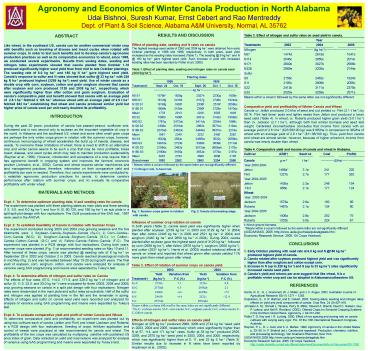ABSTRACT - PowerPoint PPT Presentation
1 / 1
Title:
ABSTRACT
Description:
In order to test such benefits and to develop canola's agronomic ... Raymer, P. L., D. L. Auld, and K. A. Mahler. 1990. Agronomy of canola in the United States. ... – PowerPoint PPT presentation
Number of Views:21
Avg rating:3.0/5.0
Title: ABSTRACT
1
Agronomy and Economics of Winter Canola
Production in North Alabama Udai Bishnoi, Suresh
Kumar, Ernst Cebert and Rao Mentreddy Dept. of
Plant Soil Science, Alabama AM University,
Normal, AL 35762
ABSTRACT Like wheat, in the southeast US,
canola can be another commercial winter crop with
benefits such as breaking of disease and insect
cycles when rotated with summer crops. In order
to test such benefits and to develop canolas
agronomic production practices as well as its
comparative economics to wheat, since 1998, we
conducted several experiments. Results from
sowing dates, seeding and nitrogen
rates experiments showed that canola planted from
October 1-10 produced significantly higher seed
yield than from mid to late October plantings.
The seeding rate of 6.0 kg ha-1 and 180 kg N ha-1
gave highest seed yield. Canolas response to
sulfur and N rates showed that sulfur _at_ 33 kg
ha-1 with 228 kg N ha-1 produced highest (3259 kg
ha-1) seed yield. Use of winter canola as a
double crop with corn, soybean, cotton and grain
sorghum showed that canola after soybean and corn
produced 3129 and 2938 kg ha-1, respectively,
which were significantly higher than after cotton
and grain sorghum. Evaluation of canolas
comparative yield and benefit showed that canola
with an average yield of 2.6 t ha-1 fetched
185 ha-1 whereas wheat with an average yield of
2.9 t ha-1 fetched 82 ha-1 establishing that
wheat and canola produced similar yield but
higher price of canola seed per unit nearly
doubled its profitability. INTRODUCTION During
the past 20 years, production of canola has
passed peanut, sunflower and, cottonseed and is
now second only to soybean as the important
vegetable oil crop in the world. In Alabama and
the southeast US, wheat and some other small
grain crops are perhaps the only winter crops
grown in rotation with the summer crops, however,
continuous monocropping of wheat accelerates the
build up of insects, disease, and weeds. To
overcome these limitations of wheat, there is
need to shift to an alternative crop and winter
canola seems to be such a crop that may be more
profitable, break insect, disease, and weed
cycles which may help to maintain production
sustainability (Raymer et al., 1990). However,
introduction and acceptance of a crop require
that it has agronomic benefit in cropping system
and improves the farmers' economic position
(Johnston, et al., 2002). Canola and wheat
requires similar machineries and land management
practices, therefore, information on their
comparative yield and profitability per acre is
needed. Therefore, four canola experiments were
conducted to i) establish agronomic production
practices for canola, ii) determine canolas
performance after rotation with summer crops, and
iii) evaluate its comparative profitability with
winter wheat. MATERIALS AND METHODS Expt.
1 To determine optimum planting date, N and
seeding rates for canola The experiment was
planted with three planting dates as main plots
and three seeding (1.5, 3.0, and 6.0 kg ha-1) and
four N (0, 60,120, and 180 kg ha-1) as sub plots
in a split-split plot design with four
replications. The GLM procedures of the SAS
Inst., 1997 were used in the ANOVA. Expt. 2 To
establish feasibility of Canola in rotation with
Summer Crops The experiment conducted during 2003
and 2004 crop growing seasons and the five
treatments were i) Soybean--Canola--Soybean--Cano
la (Sy-C) ii) Corn--Canola--Corn--Canola (M-C)
iii) Sorghum--Canola--Sorghum--Canola (S-C) iv)
Cotton--Canola--Cotton--Canola (G-C) and vi)
Fallow--Canola--Fallow--Canola (F-C). The
experiment was planted in a RCB design with four
replications. During both years, summer crops
were planted (Fig. 1) at recommended seeding
rates on May 10 and 11. After harvest of these
crops, canola was planted _at_ seeding rate of 6 kg
ha-1 on September 28 in 2002 and October 2 in
2003. Canola reached physiological maturity in
mid May (Fig. 2) and was harvested between May
15-20 during both years. The final yield of
soybean, corn, sorghum, cotton, and canola were
analyzed for analysis of variance using SAS
programming and means were separated by Tukeys
test. Expt. 3 To determine effects of nitrogen
and sulfur rates on Canola The effects of four
rates (57.0, 114.0, 171.0, and 228.0 kg ha-1) of
nitrogen and of sulfur (0, 11.0, 22.0, and 33.0
kg ha-1) were evaluated for three (2003, 2004 and
2005) crop growing seasons on canola in a split
plot design with four replications. Nitrogen
rates were randomized in the main plots and
sulfur rates as sub-plots. Half of the sulfur and
nitrogen was applied at planting time in the fall
and the remainder in spring. Effects of nitrogen
and sulfur on canola seed yield were recorded and
analyzed for analysis of variance using SAS
programming and means were separated by Tukeys
test. Expt. 4 To evaluate comparative yield and
profit of winter Canola and Wheat To determine
comparative yield and profitability, an
experiment was planted out by using two cultivars
each of canola (Jetton and Flint) and wheat
(Jackson and Roberts) in a RCB design with four
replications. Seeding of crops, fertilizer
application and control of weeds were practiced
at rate recommended for canola and wheat. The
profitability of the two crops was calculated by
multiplying yield/ha with published US price
index of grain. Data collected on yield and
income/acre was analyzed for analysis of variance
using SAS programming and means were separated by
Tukeys test.
Corn
N57 S11
N228 S33
Cotton
Sorghum
Soybean
Corn
Sorghum
N171 S22
Soybean
Cotton































